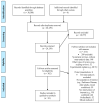Virtual Reality in Neurorehabilitation: An Umbrella Review of Meta-Analyses
- PMID: 33918365
- PMCID: PMC8038192
- DOI: 10.3390/jcm10071478
Virtual Reality in Neurorehabilitation: An Umbrella Review of Meta-Analyses
Abstract
Neurological disorders are a leading cause of death and disability worldwide. Can virtual reality (VR) based intervention, a novel technology-driven change of paradigm in rehabilitation, reduce impairments, activity limitations, and participation restrictions? This question is directly addressed here for the first time using an umbrella review that assessed the effectiveness and quality of evidence of VR interventions in the physical and cognitive rehabilitation of patients with stroke, traumatic brain injury and cerebral palsy, identified factors that can enhance rehabilitation outcomes and addressed safety concerns. Forty-one meta-analyses were included. The data synthesis found mostly low- or very low-quality evidence that supports the effectiveness of VR interventions. Only a limited number of comparisons were rated as having moderate and high quality of evidence, but overall, results highlight potential benefits of VR for improving the ambulation function of children with cerebral palsy, mobility, balance, upper limb function, and body structure/function and activity of people with stroke, and upper limb function of people with acquired brain injury. Customization of VR systems is one important factor linked with improved outcomes. Most studies do not address safety concerns, as only nine reviews reported adverse effects. The results provide critical recommendations for the design and implementation of future VR programs, trials and systematic reviews, including the need for high quality randomized controlled trials to test principles and mechanisms, in primary studies and in meta-analyses, in order to formulate evidence-based guidelines for designing VR-based rehabilitation interventions.
Keywords: cerebral palsy; neurological disorders; rehabilitation; stroke; traumatic brain injury; virtual reality.
Conflict of interest statement
The authors declare no conflict of interest.
Figures
References
-
- World Health Organization . Neurological Disorders: Public Health Challenges. World Health Organization; Geneva, Switzerland: 2006.
-
- Piron L., Turolla A., Agostini M., Zucconi C., Cortese F., Zampolini M., Zannini M., Dam M., Ventura L., Battauz M., et al. Exercises for paretic upper limb after stroke: A combined virtual-reality and telemedicine approach. J. Rehabil. Med. 2009;41:1016–1102. doi: 10.2340/16501977-0459. - DOI - PubMed
Publication types
LinkOut - more resources
Full Text Sources
Other Literature Sources


